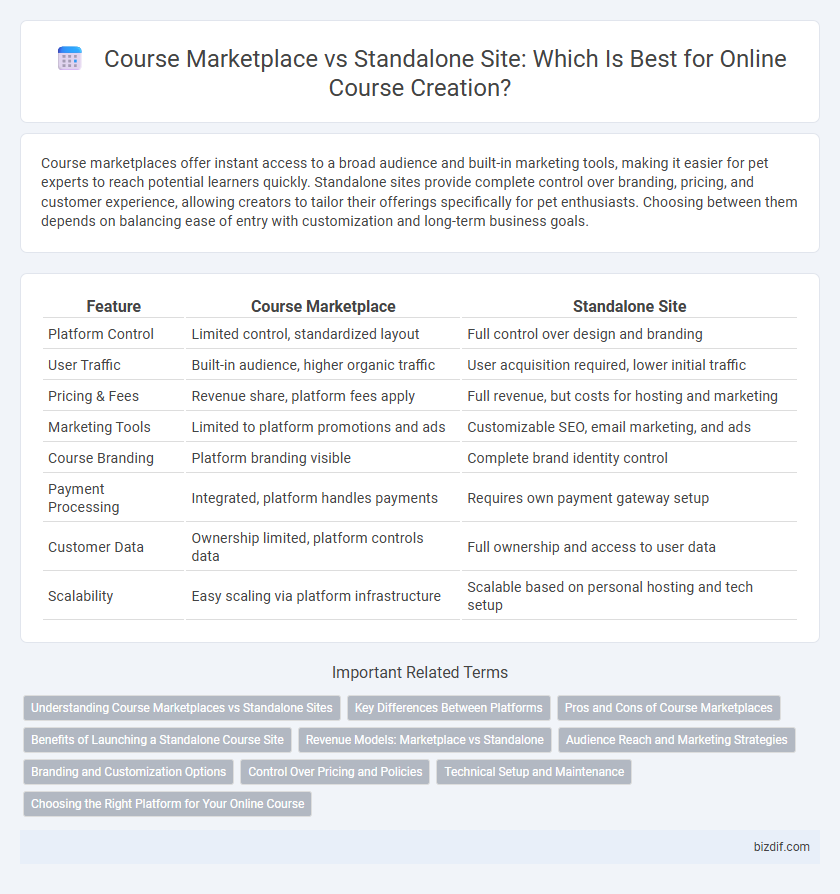Course marketplaces offer instant access to a broad audience and built-in marketing tools, making it easier for pet experts to reach potential learners quickly. Standalone sites provide complete control over branding, pricing, and customer experience, allowing creators to tailor their offerings specifically for pet enthusiasts. Choosing between them depends on balancing ease of entry with customization and long-term business goals.
Table of Comparison
| Feature | Course Marketplace | Standalone Site |
|---|---|---|
| Platform Control | Limited control, standardized layout | Full control over design and branding |
| User Traffic | Built-in audience, higher organic traffic | User acquisition required, lower initial traffic |
| Pricing & Fees | Revenue share, platform fees apply | Full revenue, but costs for hosting and marketing |
| Marketing Tools | Limited to platform promotions and ads | Customizable SEO, email marketing, and ads |
| Course Branding | Platform branding visible | Complete brand identity control |
| Payment Processing | Integrated, platform handles payments | Requires own payment gateway setup |
| Customer Data | Ownership limited, platform controls data | Full ownership and access to user data |
| Scalability | Easy scaling via platform infrastructure | Scalable based on personal hosting and tech setup |
Understanding Course Marketplaces vs Standalone Sites
Course marketplaces offer built-in audiences and streamlined marketing tools, enabling creators to reach global learners without extensive promotional effort. Standalone sites provide full control over branding, pricing, and user experience, allowing for personalized course delivery and direct customer relationships. Evaluating goals like scalability, customization, and revenue share helps determine whether marketplaces or standalone platforms best suit course creators' needs.
Key Differences Between Platforms
Course marketplaces offer built-in audiences and simplified marketing tools, enabling creators to reach a wide range of potential students quickly. Standalone sites provide full control over branding, pricing, and customer data, allowing for a personalized user experience and long-term business growth. The key differences lie in audience access, customization options, and revenue sharing models, impacting scalability and profitability for course creators.
Pros and Cons of Course Marketplaces
Course marketplaces offer extensive exposure to large audiences, reducing marketing efforts and providing built-in payment processing and technical support, which benefits new or smaller course creators. However, they often charge high commissions and fees, limiting profit margins, and restrict branding customization, making it harder to build a unique online presence. Marketplaces also impose content guidelines and competition with similar courses, which can affect course visibility and pricing control.
Benefits of Launching a Standalone Course Site
Launching a standalone course site offers complete control over branding, user experience, and pricing strategies, allowing creators to build a unique and cohesive learning environment. This autonomy facilitates direct customer relationships, enhancing marketing opportunities and maximizing revenue without sharing profits with marketplace platforms. Furthermore, a standalone site enables customization of course content delivery and integration with third-party tools, optimizing the educational journey and increasing student engagement.
Revenue Models: Marketplace vs Standalone
Course marketplaces typically generate revenue through transaction fees ranging from 10% to 30%, leveraging high traffic and built-in audience exposure to drive sales. Standalone sites rely on subscription models, one-time payments, or tiered pricing structures, allowing creators full control over pricing and customer data but requiring independent marketing efforts. Choosing between these models depends on balancing revenue share versus brand ownership and long-term customer relationships.
Audience Reach and Marketing Strategies
Course marketplaces provide access to a large, built-in audience by leveraging established traffic and user trust, making them ideal for creators aiming for immediate visibility. Standalone sites offer full control over branding and marketing, enabling customized SEO strategies and direct customer relationships but require significant effort to build and maintain audience reach. Choosing between the two depends on balancing quick exposure with long-term brand development and marketing autonomy.
Branding and Customization Options
Course marketplaces offer limited branding and customization options, restricting creators to preset templates and platform-wide design standards that can dilute their unique identity. Standalone sites provide comprehensive control over branding elements, including logos, color schemes, and user experience, allowing creators to build a distinctive and memorable brand presence. Customization flexibility on standalone platforms enhances course differentiation, improves student engagement, and supports long-term brand growth.
Control Over Pricing and Policies
Course marketplaces often impose standardized pricing structures and policy guidelines that limit instructors' flexibility in setting course fees and refund terms. Standalone sites provide complete control over pricing models, discounts, and enrollment policies, enabling personalized marketing strategies and customer engagement. This autonomy directly impacts revenue optimization and brand differentiation in the competitive online education sector.
Technical Setup and Maintenance
Setting up a course marketplace requires integrating with established platforms like Udemy or Skillshare, minimizing technical maintenance but limiting customization options. In contrast, a standalone site demands comprehensive technical setup, including web hosting, LMS plugins, SSL certificates, and regular updates to ensure security and performance. Maintenance for standalone sites often involves troubleshooting, backups, and scalability management, offering full control at the cost of higher technical responsibility.
Choosing the Right Platform for Your Online Course
Selecting between a course marketplace and a standalone site hinges on your goals, audience reach, and control preferences. Course marketplaces like Udemy and Coursera offer vast built-in audiences and marketing tools, ideal for creators seeking broad exposure without managing technical details. Standalone sites provide full branding, customization, and revenue control but require investing in website development, marketing strategies, and hosting solutions.
Course marketplace vs Standalone site Infographic

 bizdif.com
bizdif.com